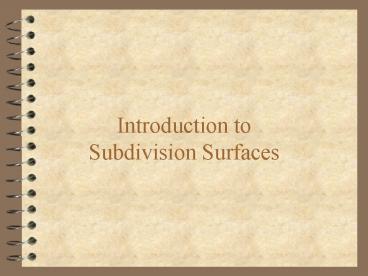Introduction to Subdivision Surfaces - PowerPoint PPT Presentation
Title:
Introduction to Subdivision Surfaces
Description:
In each iteration, the subdivision operator refines the control net, increasing ... Every subdivision method has a method to generate the topology of the refined ... – PowerPoint PPT presentation
Number of Views:133
Avg rating:3.0/5.0
Title: Introduction to Subdivision Surfaces
1
Introduction toSubdivision Surfaces
2
Subdivision Curves and Surfaces
- Subdivision curves
- The basic concepts of subdivision.
- Subdivision surfaces
- Important known methods.
- Discussion subdivision vs. parametric surfaces.
3
Corner Cutting
4
Corner Cutting
3 1
1 3
5
Corner Cutting
6
Corner Cutting
7
Corner Cutting
8
Corner Cutting
9
Corner Cutting
10
Corner Cutting
11
Corner Cutting
12
The 4-point scheme
13
The 4-point scheme
14
The 4-point scheme
1 1
1 1
15
The 4-point scheme
1 8
16
The 4-point scheme
17
The 4-point scheme
18
The 4-point scheme
19
The 4-point scheme
20
The 4-point scheme
21
The 4-point scheme
22
The 4-point scheme
23
The 4-point scheme
24
The 4-point scheme
25
The 4-point scheme
26
The 4-point scheme
27
The 4-point scheme
A control point
The limit curve
The control polygon
28
Subdivision curves
- Non interpolatory subdivision schemes
- Corner Cutting
- Interpolatory subdivision schemes
- The 4-point scheme
29
Basic concepts of Subdivision
- A subdivision curve is generated by repeatedly
applying a subdivision operator to a given
polygon (called the control polygon). - The central theoretical questions
- Convergence Given a subdivision operator and a
control polygon, does the subdivision process
converge? - Smoothness Does the subdivision process converge
to a smooth curve?
30
Subdivision schemes for surfaces
- A Control net consists of vertices, edges, and
faces. - In each iteration, the subdivision operator
refines the control net, increasing the number of
vertices (approximately) by a factor of 4. - In the limit the vertices of the control net
converge to a limit surface. - Every subdivision method has a method to generate
the topology of the refined net, and rules to
calculate the location of the new vertices.
31
Triangular subdivision
Works only for control nets whose faces are
triangular.
New vertices
Old vertices
- Every face is replaced by 4 new triangular faces.
- The are two kinds of new vertices
- Green vertices are associated with old edges
- Red vertices are associated with old vertices.
32
Loops scheme
Every new vertex is a weighted average of the old
vertices. The list of weights is called the
subdivision mask or the stencil.
A rule for new red vertices
A rule for new green vertices
1
1
1
1
1
n - the vertex valency
33
The original control net
34
After 1st iteration
35
After 2nd iteration
36
After 3rd iteration
37
The limit surface
The limit surfaces of Loops subdivision have
continuous curvature almost everywhere.
38
The Butterfly scheme
This is an interpolatory scheme. The new red
vertices inherit the location of the old
vertices. The new green vertices are calculated
by the following stencil
39
The original control net
40
After 1st iteration
41
After 2nd iteration
42
After 3rd iteration
43
The limit surface
The limit surfaces of the Butterfly subdivision
are smooth but are nowhere twice differentiable.
44
Quadrilateral subdivision
Works for control nets of arbitrary topology.
After one iteration, all the faces are
quadrilateral.
Old vertices
New vertices
Old face
Old edge
- Every face is replaced by quadrilateral faces.
- The are three kinds of new vertices
- Yellow vertices are associated with old faces
- Green vertices are associated with old edges
- Red vertices are associated with old vertices.
45
Catmull Clarks scheme
Step 3
Finally, the red vertices are calculated using
the values of the yellow vertices
1
1
1
1
1
1
1
1
1
1
n - the vertex valency
46
The original control net
47
After 1st iteration
48
After 2nd iteration
49
After 3rd iteration
50
The limit surface
The limit surfaces of Catmull-Clarkss
subdivision have continuous curvature almost
everywhere.































